Grass needs water, but how much? The combined loss of water from
plants and soil ("evapotranspiration") was measured in a classic
turf study in Central Texas (Table
1).
 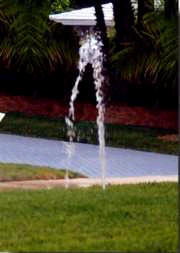 Central
Texas gets about 42 inches of rainfall. But typically dry
weather in July and August means that just about all the turf water must
come from irrigation. And in March through
June, rainfall is present, on average, but sporadic. Central
Texas gets about 42 inches of rainfall. But typically dry
weather in July and August means that just about all the turf water must
come from irrigation. And in March through
June, rainfall is present, on average, but sporadic.
The story is more
complicated. Soils with good water holding capacity, such as
organic soils, provide more water reserve for the roots than sand soils.
Turf grown near heat sources, such as pavement, uses more water, while
turf under trees uses less water.
The process of water
loss by plants is a simple physical process of heat exchange. This
is proven by the coolness of your bare skin when you walk out of the
water, and the heat rising from the stove where you boil water.
Plants generally differ little in how much water they use. Forests use a little more water than grasslands, hence forests generally
occur in moist regions, and grasslands in arid regions. Except for
cacti and other succulents, most plants use about the same amount of
water. The main difference is that some plants need more
irrigation, while other plants, woody plants especially, are better at
tapping the underground reserves. With its long roots, bahiagrass
can generally be grown in level areas of south Texas with no irrigation.
|
Month |
Water use (inches) |
 |
| January |
2.0 |
|
| February |
2.5 |
|
| March |
3.4 |
|
| April |
4.2 |
|
| May |
5.2 |
|
| June |
4.3 |
|
| July |
4.8 |
|
| August |
4.8 |
|
| September |
3.9 |
|
| October |
3.4 |
|
| November |
2.5 |
|
| December |
1.9 |
|
| Total |
42.8
|
|
|
Means
of five years' observations of evapotranspiration on St.
Augustinegrass turf. |
|
|
Return to top |
|
 |
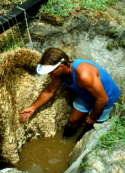 |
Typically, in Central Texas soils St.
Augustine grass has about 3/4 inch total soil moisture reserve, which is
how much water it loses before it wilts. The simplest way to know when
the lawn has lost this much water is to watch it
wilt. If you notice gray areas which "footprint," and individual
leaf blades that are curled, it's time to irrigate, and damage is being
done. The wilting is
normally noticed in the late afternoon, and the turf should be watered
the following morning, or certainly within a few days.
Since irrigation systems are not perfectly
tuned to provide 3/4 inch to every corner of the lawn, one would
normally water more than this amount. How much depends on how the irrigation system
is. The simplest way to find out is to place
straight-sided containers, such as coffee cans or frozen
drink concentrate cans, 10 or 20 per lawn, and run the sprinklers. If the sprinklers put
out 3 inches in one hour, then you can figure on watering for 15 minutes
to provide the average turf needs, until the next time it wilts.
 |
 |
Uniformity is the goal
of a good irrigation system. Bad irrigation wastes water. Generally the sprinkler heads
of a irrigation system should be close enough that the spray or stream from each head just barely touches
the neighboring heads. So if your sprinklers are place on a square
grid, the arc from each head must touch four other heads. Except
along the edges and corners of the landscape, half- and quarter- circle
matched precipitation heads would be used so as not to put water on the
street or building. Make sure you have an adequate water source, that you don't
have too many heads per zone, and that pressure, pipe size, and layout
make sense. Retail outlets that sell sprinkler parts normally have
free pamphlets or booklets that will tell you how.
One way is to shut off the irrigation. It's often the dry
season when we see how poorly our sprinklers
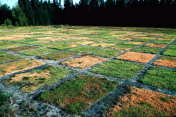 have
been working. have
been working.
The photo shows a
planned curtailment, to measure differences in drought survival among
different St. Augustine grasses. Some of the grasses were totally
killed and others survived.
In other studies, the
killing injury (damage %,
below) was closely associated with the number of days wilt.
While FX-10 and Floratam were slower to wilt than Bitterblue and
Seville, once a grass had been wilting off-and-on for a week, it was on
a death course.
| |
 |
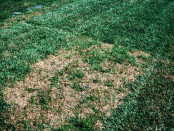 |
|
After the first week or so, St. Augustine grass plots suffered 15%
loss of canopy per day. Plots which underwent two weeks of wilt
were completely killed. Any subsequent recovery was from stolons
growing in from the sides.
Actual results which you
might experience in a lawn will vary according to microenvironment,
e.g., the presence of trees, exposure to the wind, the quality of your
soil, and the condition of the turf. Other organisms, such as
nematodes, can compromise the root system and make the grass less able
to stand up to lack of water. Grass which has been fertilized
recently with highly soluble fertilizer often wilts quickly. The
Texas experiment was done in a microenvironment of sandy soil under full
sun exposure.
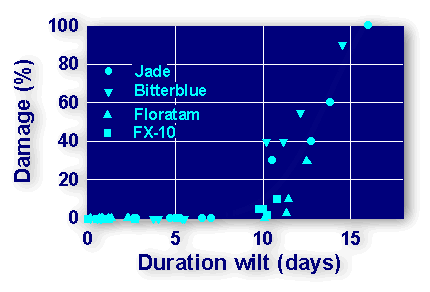 Technically,
St. Augustine grass uses only a little more water than other, drought
avoidant grasses such as bermuda grass and bahia grass. What
probably lends to the severity of drought damage in St. Augustine grass
is the exposure of the horizontal above-ground stems ("stolons") to
desiccation. In contrast, bahia grass stolons are partially
protected by the clasping leaf sheaths. Bermuda grass and
zoysia grass have much of their stem material below the ground
(rhizomes), and rhizomes are not only protected from desiccation by
the soil, but they tend to be in a semi-dormant condition,
thus are more resistant to desiccation. Technically,
St. Augustine grass uses only a little more water than other, drought
avoidant grasses such as bermuda grass and bahia grass. What
probably lends to the severity of drought damage in St. Augustine grass
is the exposure of the horizontal above-ground stems ("stolons") to
desiccation. In contrast, bahia grass stolons are partially
protected by the clasping leaf sheaths. Bermuda grass and
zoysia grass have much of their stem material below the ground
(rhizomes), and rhizomes are not only protected from desiccation by
the soil, but they tend to be in a semi-dormant condition,
thus are more resistant to desiccation.
Lawns shouldn't be
watered as soon as it wilts, as there's a
chance it may rain within a few days from the first wilt, and generally
it's safe to watch and wait. Wilt is typically noticed at first in
the mid-afternoon, 2 to 3 p.m. Daylight Savings Time, and the lawn
becomes turgid again by the next morning. The progression of
afternoon wilt can continue for a week or so, expanding in area and
occurring earlier in the afternoon. When the lawn still
remains wilted the following morning it is on its death course. During this progression, traffic should be kept off the turf. Any new growth in
grasses must come from the stems. Once the stems have dried
excessively, the turfgrass plant can make no more leaves, roots, or
stems.
Mowing
Before mowing be sure the mower blade is sharp.
A dull blade will bruise and tear the grass tips, and they will
eventually turn brown. Mow when the grass is dry to eliminate shredding
and whipping of the grass blades. Base the mowing on the growth rate of the grass
rather than on a set time schedule. Never mow more than 1/3 of the
grass blade. With this small amount of grass being cut, the clippings
won't have to be bagged. Leaving the clippings on the grass will
actually return the nutrients to the soil. Contrary to popular belief,
clippings left on the lawn are not a significant contributor to thatch. As the summer progresses and the temperature
increases, raise the mower to 2 1/2 to 3 inches. The grass will be
stronger and better able to survive drought when it is mowed at a higher
cut. It will also discourage germination of weed seeds and insulate the
soil against the drying heat. Mow the lawn into the fall until the grass stops
growing.
Thatch
Thatch is a major concern with some lawns. Some thatch
is normal and even beneficial, as it acts as a mulch to retain moisture
and keep soil temperatures cool. Thatch also discourages germination of
weed seeds and as it decays it adds nutrients to the soil. But once
thatch accumulates to more than 1/2 inch, it can choke your lawn and
invite trouble from disease and insects. A healthy lawn in central Texas
will generally not have a thatch problem.
Thatch is a tightly intermingled layer of living
and dead stems, leaves and roots, which develops between the layer of
green vegetation and the soil surface. To keep the amount of thatch
down, the lawn needs better conditions for micro-organisms and
decomposition of organic matter.
Aeration can be done in the spring or fall of the year to allow for
better water and air infiltration, and nutrient mobility. Aeration
also improves the physical condition of the soil by relieving compaction
and will help with all plant and soil processes, while keeping thatch at
a desired level.
Free analysis and price quote

|
